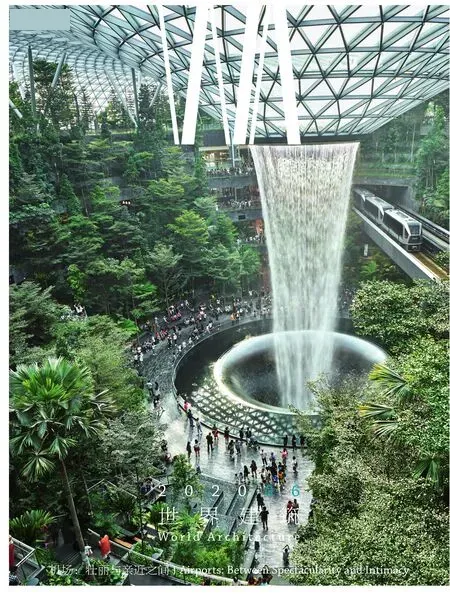樟宜机场T4航站楼,新加坡
建筑和室内方案设计:贝诺建筑设计公司
Concept Design Architect and Interior Designer: Benoy Limited
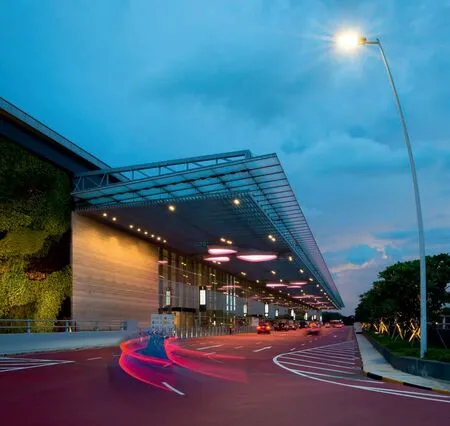
1
1 L1层出发主入口车行道/Level 1 departure car drop off
2 L1层出发主入口公交车泊车入口/Level 1 departure bus drop-off entrance
至2013 年,樟宜机场原有3 座航站楼和1 座廉价航站楼,旅客数量包达到每年5370 万人次。樟宜机场集团(CAG)决定再新建一座航站楼来取代已有的廉价航站楼,以满足未来的旅客需求。
樟宜机场集团旨在将T4 航站楼打造成一座符合机场发展愿景与理念、面向未来的体验胜地。而在运营层面,CAG 希望这座年均吞吐能力可达1600 万人次的大型现代化机场航站楼能够带来卓越的经济效益,且与此同时,“活力隽永,妙趣横生,精彩纷呈”,这一切的高品质追求源于樟宜的不变理念——提供热情周到的服务、舒适贴心的感受和多姿多彩的体验,最重要的是,创造令人愉悦的顾客体验。
经过一番严格遴选,2012 年,樟宜机场委托贝诺承担T4 航站楼建筑和室内设计的方案设计。作为整个项目团队的一部分,贝诺与SAA(负责建筑与合同管理)、Aecom(负责结构工程)、Beca(负责MEP 机电暖通和IT 工程科技)、Ignesis(负责消防工程)、Lichtvision(负责照明设计)和ICN(负责景观设计)联合完成了这项宏大的工程。
2012-2014 年,T4 航站楼项目团队完成了概念方案、建筑及工程设计,并于2014 年初开始动工,于2016 年12 月16 日竣工,最终工程造价12.8 亿新加坡元(10.3 亿美元),并已于2017 年10 月31日正式向公众开放。
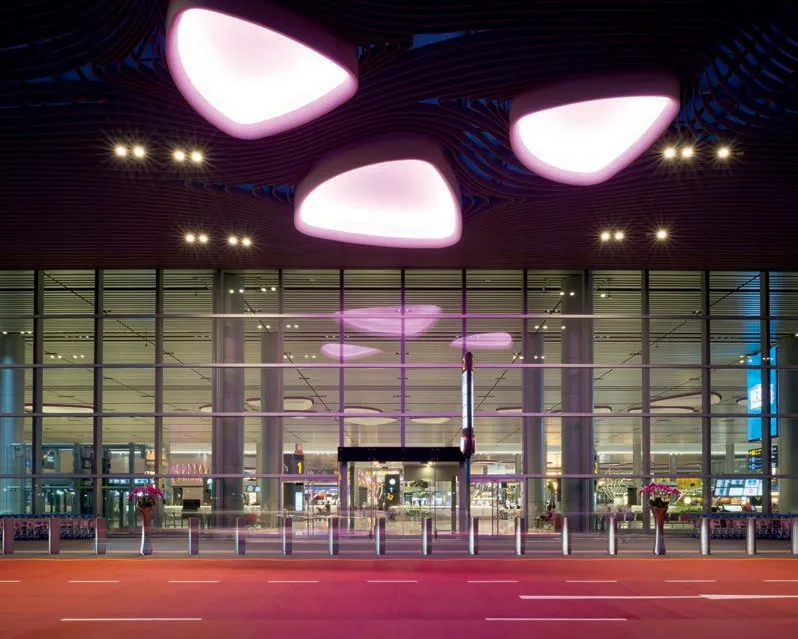
2
唤起身临其境的归属感
樟宜机场T4 航站楼总建筑面积225,000m2,通过一个光彩耀目的多层娱乐综合体“星耀樟宜”与机场的其他主要航站楼相连。星耀樟宜和T4 航站楼均融入了丰富的生态元素;例如星耀樟宜拥有一片栩栩如生的热带雨林和星空花园,而T4 航站楼内则栽种了50 多万株室内绿植和树木。
设计团队希望借助这一绿意盎然的设计将航站楼与新加坡郁郁葱葱的园林景观联系起来,实现CAG 的一大设计目标:唤起一种身临其境的归属感。因此,在概念设计时,设计团队充分考虑了当地的风土人情。例如,在航站楼建筑中融入兰花(新加坡国花)的设计元素,67 个花瓣状的天窗悬浮在中央广场上,为航站楼增添了精美雅致的气息。地毯、重要节点和软装陈设上也零星散布着兰花图案装饰。其他各处广泛运用玻璃和透明设计,不仅形成开阔的视野,让旅客可以清晰地将周围环境尽收眼底,也打破了航站楼与外界的隔阂,实现无缝衔接。
在传统文化区内,一排出售传统美食和本土产品的店铺门头设计极富娘惹建筑风格,也让这种身临其境的归属感愈加形象,充满狮城风情。店铺外门头及外立面装饰生动讲述了中国巴洛克风格和新加坡折衷主义建筑的演变历程,同时表现了充满浓厚的1930 年代新加坡民众的生活气息。
旅客手续办理行程与体验
顺利完成一系列手续办理流程是樟宜机场旅客体验的一大关键组成部分。航站楼入口处设有红毯式车行道,热情欢迎到达樟宜机场的旅客。旅客进入出发厅后在自助值机亭和自助行李托运处办理自动值机及行李托运,然后可以在此通过直观的FAST(畅快通行)系统完成护照扫描、登机牌打印等全套便捷操作,之后便可进入航站楼。
而在自助通关闸门,旅客只需再次扫描护照,通过面部和指纹识别确认身份就能快速顺利通关。整个过程快速、便捷而灵活。为缓解旅客的压力感,安检区配置了各类可以分散注意力的设施,尤其是被称为“樟宜奇迹墙”的交互式LED 屏和显示器,上面显示有各种趣味元素,帮助旅客放松心情。
集中式安检系统技术是樟宜机场T4 航站楼的一大前沿亮点。樟宜机场首次在T4 航站楼使用100%计算机断层扫描X 光机来扫描旅客的随身行李。借助配备自动威胁检测功能的3D 包裹成像技术,旅客无需将笔记本电脑从包中取出就可以通过安检,从而进一步减少排队时间,加快通行。
通过安检后,旅客进入航站楼绿树成荫的商业零售通道,这里同样充分运用了空间、灯光和绿植来优化旅客体验。零售商店一路延伸至中央圆顶,与柔和的建筑边界和曲线元素相拥交汇。这些优雅设计在不知不觉中产生引导作用,让旅客在浏览、购物和漫步时慢慢地向前移动。这是樟宜机场穿行式零售体验的首次尝试,80 多家零售店铺和餐厅,300m 长的中央广场,以及一片拥有独特“零售娱乐”热点的免税区在此汇集。
在航站楼的这一中心位置,透明美学的设计理念令人惊艳——大跨度结构体系免去了大量承重柱,开辟出大面积贯通的内部空间,而用来分隔陆侧与空侧的传统墙体也被梦幻的玻璃海洋所掩盖。整片区域视线明亮通透,旅客在通过该区域时从很远处就能看见到达的亲友。
出发中转区域同样设有零售店铺和餐厅,旅客通过自动登机门就可以顺利登机。
可持续运营
樟宜机场T4 航站楼也是可持续机场设计的创新典范。T4 航站楼采用高性能的建筑围护结构,随处可见的玻璃和天窗元素使光线能够最大限度地透入,从而减少日间的人工照明需求。在低峰时段将部分区域的灯光调暗,日落后使用LED 灯照亮航站楼内部。通过精密的能源管理系统,CAG 可以监测整个航站楼的能源消耗情况。可持续设计还涵盖水资源管理,包括T4 航站楼空调机组(AHU)冷凝水的回收以及雨水收集和泄漏检测。
通过这些举措,T4 航站楼不仅达到了新加坡的绿色建筑标志标准要求,而且获得了绿色建筑标志超金奖。这座航站楼俨然已成为现代机场环境的最新全球标杆。
By 2013, with Terminal 1 ,2 & 3 and a budget terminal, passenger numbers through Changi reached 53.7 million a year. Changi Airport Group (CAG) decided another terminal was needed to replace its budget facility and meet future passenger demand.
With Terminal 4, CAG set out to create an experiential and future-focused facility that aligned with the airport's vision and ethos. At an operational level, CAG wanted a large-scale, commercially viable modern airport terminal, with capacity to handle up to 16 million passengers a year. CAG also wanted T4 to be "vibrant, fun and positively surprising". These qualities link with Changi's philosophy of providing hospitality, comfort and colour - and above all, a pleasurable customer experience.
Following a rigorous selection process, in 2012 Benoy was appointed Concept Design Architect and Interior Designer for Changi T4. Working as part of a project consortium, Benoy was engaged alongside SAA (architecture and contract administration), Aecom (structural engineering), Beca (MEP and IT), Ignesis (fire engineering), Lichtvision (lighting design), and ICN (landscape design).
Between 2012 and 2014, the T4 project consortium developed the concept, architectural and engineering designs, with construction beginning in early 2014. Changi T4 was completed on 16 December 2016 at a final project cost of S$1.28bn (US$1.03bn), and officially opened to the public on 31 October 2017.
A Sense of Place
Changi T4 covers an area of 225,000m2and is connected to the airport's other main terminals via a dazzling, multi-level entertainment complex known as Jewel. Both Jewel and T4 contain strong biophilic elements; in the case of Jewel, a live rainforest and canopy park, and in T4 over 500,000 indoor plants and trees.
Through the use of biophilia, the idea was to integrate the terminal with Singapore's rich garden landscape and, in doing so, meet one of CAG's key design objectives: to evoke a sense of place. The concept designs are therefore based on the local and the vernacular. The orchid, for example, Singapore's national flower, is embedded in the terminal's architecture, with 67 petal-shaped skylights overhanging the central galleria. Multiple orchid motifs are also scattered across carpets, touchpoints and furniture. Elsewhere, passengers maintain a clear line of sight with the surrounding environment through the pervasive use of glass and transparency, creating a seamless link between the terminal and its city context.
A sense of place is also reinforced through heritage features, including a row of shophouses replicating Peranakan architecture and selling traditional food and local produce. The shophouse façades tell the story of the evolution of Chinese Baroque and Singapore Eclectic architecture, while conjuring vivid insight into life in 1930s Singapore.
The Passenger Journey and Experience
A smooth journey through the terminal is a key component of the overall passenger experience at Changi. Upon arrival, at the terminal's entrance, passengers receive a red carpet greeting and welcome. They then enter the departure area where they are met by the automated check-in and bag drop kiosks. Here, an intuitive FAST (fast and seamless travel) system enables passengers to simply scan their passports, print their boarding passes and move on into the terminal.
At the automated immigration gate, passengers again scan their passport and have their identity conf irmed via facial and thumbprint recognition. This ensures speed, convenience and flexibility. And as they move through security, passengers are offered a multiplicity of distractions to prevent any feelings of stress. In particular, interactive LED screens and displays - known as "the Changi Wonder Wall" - provide diverting elements to help promote relaxation.
Changi T4's centralised security system technology is also uniquely cutting-edge. T4 is the first of Changi's terminals to use 100% computed, tomography-based X-ray machines to scan carry-on luggage. And through the use of 3D bag imaging with auto-threat detection capabilities, passengers can pass through security without having to remove laptops from their bags, which once again minimises queuing and improves the fluidity of passenger movement.
Once through security, passengers enter the terminal's tree-lined retail spine, where the experience is again mediated through a generosity of space, light and greenery. Retail pods jut out into the central cavity, where the soft architectural edges and curves continue. These elegant features help to nudge the passenger on, enabling a gentle flow of people through the building as they browse, shop and stroll. This is Changi airport's first-ever walkthrough retail experience. It comprises over 80 retail stores and restaurants and a 300-metre central galleria, including a duty-free zone with unique "retailtainment" hotspots.
At this central point in the terminal, the aesthetic of transparency really comes into play. Large structural spans obviate the need for multiple columns, creating an open and spacious interior, while the walls that traditionally separate landside and airside dissolve in a sea of glass. Passengers passing through this zone can see relatives or arrivals from a distance, with clear lines of sight from one side to the other.
Retail and F&B outlets also line the departure transit area, while Automated Boarding Gates enable final smooth passage to the waiting aircraft.
Sustainable Operations
Changi T4 has also pushed the boundaries of sustainable airport design. With a high-performing building envelope, T4's use of glass and skylights maximises daylight penetration, reducing the need for artificial lighting by day. Dimmed lighting is used during low-peak periods in certain areas, while LEDs are deployed after sunset to illuminate the terminal's interior. A sophisticated Energy Management System also allows CAG to monitor energy consumption across the terminal. Water management, meanwhile, includes the recycling of condensate water from T4's air handling units (AHUs), plus rainwater harvesting and leak detection.
Through these initiatives, T4 airport aligns with Singapore's Green Mark standard, and has in fact achieved the Green Mark Gold Plus. It has truly set a new global benchmark for modern airport environments.
项目信息/Credits and Data
业主/Client: 樟宜机场集团/Changi Airport Group (CAG)
建筑和室内方案设计/Concept Design Architect and Interior Designer: 贝诺建筑设计公司/Benoy Limited
建筑与合同管理/Architecture and Contract Administration: SAA
结构工程/Structural Engineering: Aecom
MEP机电暖通和IT工程科技/MEP and IT: Beca
负责消防工程/Fire Engineering: Ignesis
灯光照明设计/Lighting Design: Lichtvision
景观设计/Landscape Design: ICN
建筑面积/Gross Floor Area: 225,000m2
设计时间/Design Time: 2012-2014
施工时间/Construction Time: 2014-2016.12.16
正式开放日/Official Opening Date: 2017.10.31
摄影/Photos: James Stephenson (fig.1,2,8), Owen Raggett (fig.4,6,7)
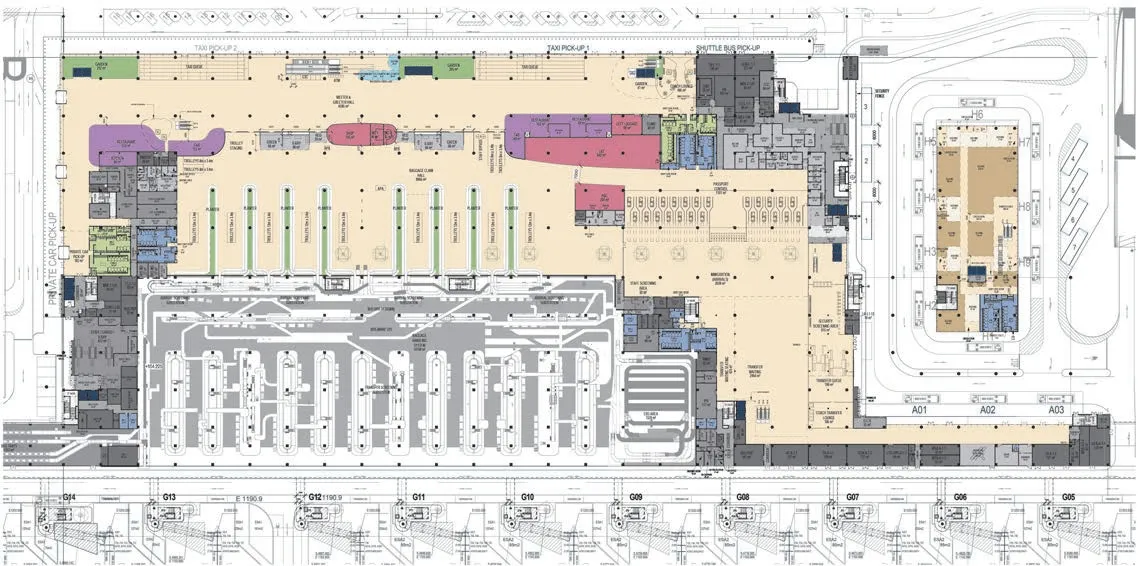
3

4
3 行李领取处平面/Baggage claim hall floor plan
4 内景/Interior view
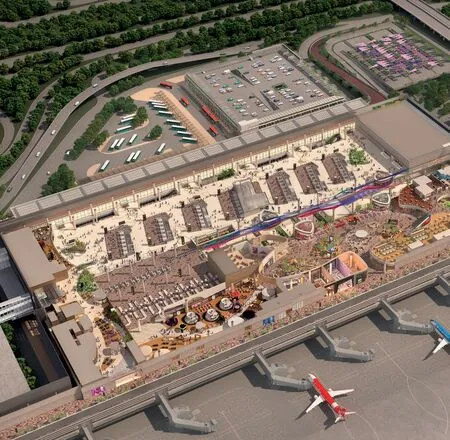

5
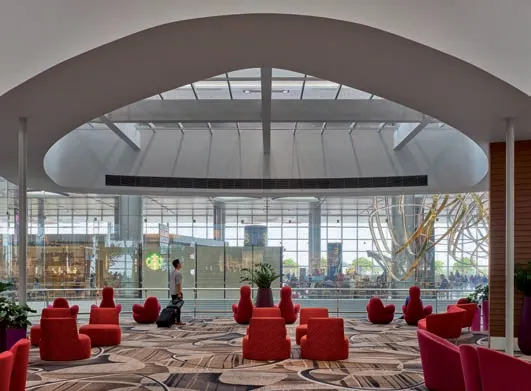
6

7

8
5 剖透视效果图/Sectional perspective rendering
6-8 内景/Interior views

